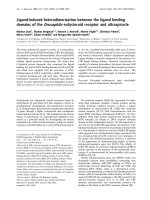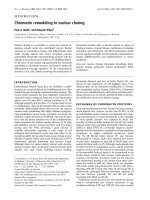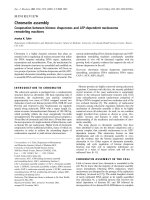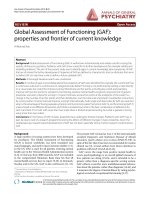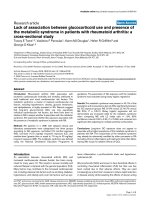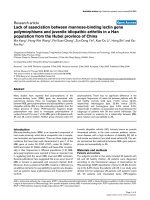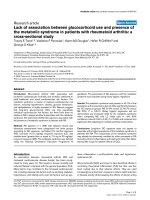Báo cáo Y học: Chromatin assembly Cooperation between histone chaperones and ATP-dependent nucleosome remodeling machines docx
Bạn đang xem bản rút gọn của tài liệu. Xem và tải ngay bản đầy đủ của tài liệu tại đây (608.23 KB, 7 trang )
MINIREVIEW
Chromatin assembly
Cooperation between histone chaperones and ATP-dependent nucleosome
remodeling machines
Jessica K. Tyler
Department of Biochemistry and Molecular Genetics, School of Medicine, University of Colorado Health Sciences Center, Denver,
CO, USA
Chromatin is a highly dynamic structure that plays an
essential role in regulating all nuclear processes that utilize
the DNA template including DNA repair, replication,
transcription and recombination. Thus, the mechanisms by
which chromatin structures are assembled and modified are
questions of broad interest. This minireview will focus on
two groups of proteins: (a) histone chaperones and (b) ATP-
dependent chromatin remodeling machines, that co-operate
to assemble DNA and histone proteins into chromatin. The
current understanding of how histone chaperones and ATP-
dependent remodeling machines coordinately assemble
chromatin in vitro will be discussed, together with the
growing body of genetic evidence that supports the role of
histone chaperones in the cell.
Keywords: chromatin; histone chaperone; nucleosome
remodeling; acetylation; DNA replication; DNA repair;
CAF-1; ACF; ASF1; Rad53.
INTRODUCTION TO CHROMATIN
The eukaryotic genome is packaged into a nucleoprotein
structure known as chromatin. The basic repeating unit of
chromatin, the nucleosome core particle, comprises
approximately two turns of DNA wrapped around two
molecules of each core histone protein; H2A, H2B, H3 and
H4 ([1]; and reviewed in [2]). Nucleosomes are regularly
spaced along eukaryotic DNA with a repeat length (i.e.
center-to-center internucleosomal distance) of 180–200 bp,
which probably reflects the most energetically favorable
arrangement [3]. The regular nucleosomal arrays comprise a
10-nm fiber of chromatin and folds into a 30-nm fiber upon
the incorporation of a single molecule of linker histone, such
as histone H1, per nucleosome. Higher levels of chromatin
compaction involve additional proteins, many of which are
unknown, in order to achieve the astounding degree of
condensation required to yield mitotic chromosomes.
Histone proteins are highly conserved among eukaryotic
organisms. Consistent with this fact, the recently published
crystal structure of the yeast nucleosome is surprisingly
similar to the metazoan nucleosome structure [1,4]. Even
some archaebacteria contain nucleosomes comprised of
80 bp of DNA wrapped around two molecules each of the
two archaeal histones [5]. The similarity of nucleosome
structures among eukaryotic organisms indicates that the
mechanism of chromatin assembly is likely to be highly
conserved across all eukaryotes. As such, we can combine
insight provided from systems as diverse as yeast, Dro-
sophila, Xenopus and humans in order to build our
understanding of the machinery and mechanism of chro-
matin assembly.
The main players in chromatin assembly that have
been identified to date are the histone chaperones and a
protein complex that remodels nucleosomes in an ATP-
dependent manner. This minireview focuses on their
identification and role in chromatin assembly in vitro,
and the evidence that the histone chaperones assemble
chromatin in vivo. Other aspects of chromatin assembly,
including cell cycle regulation of histone chaperone
function and their role in epigenetic inheritance are
covered in a series of recent reviews and will not be
addressed here [6–11].
CHROMATIN ASSEMBLY IN THE CELL
Little is known about how chromatin is assembled in the
cell. We do know that the majority of chromatin assembly
occurs immediately following DNA replication, where
nucleosomes are disrupted by the passage of the replication
machinery (reviewed in [2,7]). The naked daughter strands
of newly replicated DNA appear to be rapidly assembled
into chromatin by a multistep process that involves the
initial deposition of histones H3 and H4 followed by
incorporation of two histone H2A-H2B dimers to complete
Correspondence to J. Tyler, Department of Biochemistry
and Molecular Genetics, School of Medicine B121,
University of Colorado Health Sciences Center,
4200 East Ninth Avenue, Denver CO 80262, USA.
Fax: + 1 303 3155467, Tel.: + 1 303 3158163,
E-mail:
Abbreviations: ACF, ATP-utilizing chromatin assembly
and remodeling factor; ASF1, antisilencing function 1;
CAC1, chromatin assembly complex 1; CAF-1, chromatin assembly
factor 1; CHRAC, chromatin accessibility complex; ISWI, imitation
switch; NAP-1, nucleosome assembly protein 1; NURF, nucleosome
remodeling factor; PCNA, proliferating cell nuclear antigen; RSF,
remodeling and spacing factor.
Dedication: This Minireview Series is dedicated to Dr Alan Wolffe,
deceased 26 May 2001.
(Received 8 October 2001, revised 21 November 2001,
accepted 29 November 2001)
Eur. J. Biochem. 269, 2268–2274 (2002) Ó FEBS 2002 doi:10.1046/j.1432-1033.2002.02890.x
the nucleosome. The parental nucleosomes disassemble into
H3-H4 tetramers and H2A-H2B dimers and are then
distributed, by an unknown mechanism, randomly between
the two daughter DNA duplexes [12]. However, the
parental chromatin only provides half of the histones that
are required; the remainder is synthesized de novo during S
phase of the cell cycle [13].
The first step in the assembly of chromatin is the
nuclear import of the newly synthesized core histones.
This is mediated by a network of soluble transport
receptors called karyopherins (Kaps, also called importins,
exportins, and transportins) that bind to the nuclear
localization signal in the N-terminal domain of each core
histone [14,15]. These newly synthesized histones are
acetylated at lysine residues 5 and 12 of H4, and lysine
residue 14 of H3 (in Drosophila) prior to their assembly
into chromatin, and are rapidly deacetylated after their
deposition onto newly replicated DNA [16,17]. The
functional relevance for this specific pattern of histone
acetylation and subsequent deacetylation during chroma-
tin assembly is not understood. In vivo,theN-terminal
domains of histone H3 and H4 are functionally redundant
for chromatin assembly [18]. Furthermore, in the absence
of the N-terminal domain of histone H3, acetylation of
only lysine 5, 8, or 12 of histone H4 is required for
chromatin assembly [19]. The acetylation of histone
N-terminal domains is not required for the deposition of
histones onto the DNA, but has recently been shown to
facilitate the regular spacing of nucleosomes during
chromatin assembly in vitro [20].
CHROMATIN ASSEMBLY IS MEDIATED
BY HISTONE CHAPERONES
Key insight into the mechanism of chromatin assembly in
the cell has been provided by biochemical studies of
histone–DNA interactions. Histone proteins are rich in
positively charged basic amino acids that have an intrinsic
affinity for the negatively charged phosphate groups in
DNA; mixing histones and DNA in vitro at physiological
salt concentration leads to the rapid formation of undefined
insoluble aggregates (Fig. 1A). However, the presence of
additional anionic factors that shield the charge of the
histones from DNA, allow chromatin assembly to occur in
a regulated and ordered manner (Fig. 1B). It would appear
that additional negatively charged molecules can act as
histone chaperones to allow H3-H4 tetramers to bind to
DNA first, due to their higher affinity for DNA as
compared to H2A-H2B dimers (Fig. 1B). The subsequent
deposition of H2A-H2B dimers is likely to be driven by the
higher affinity of H2A-H2B for subnucleosomal particles
comprising DNA and H3-H4, as compared to their affinity
for either a histone chaperone or DNA [21]. As such,
chromatin assembly that is mediated by histone chaperones
in vitro mimics the stepwise process that occurs in the cell.
Using biochemical approaches to search for physiolog-
ically relevant histone chaperones has led to the identifica-
tion of numerous molecules that can bind to histone
proteins and facilitate chromatin assembly in vitro (reviewed
in [22,23]). Unfortunately, this area of research has been
fraught with artifacts due to the permissive nature of the
Fig. 1. Model for the role of histone chaperones
and remodeling machines in chromatin assem-
bly. (A) Positively charged histone proteins
and negatively charged (Ô–veÕ) DNA molecules
have a high affinity for each other and rapidly
form insoluble aggregates when mixed in vitro.
(B) Histone chaperones (defined here as any
negatively charged molecule that can bind to
histone proteins and facilitate nucleosome
formation) are likely to function by transiently
shielding the charge of the positively charged
histones from the negatively charged DNA
molecules. Histone H3-H4 tetramers have a
higher affinity for DNA (as indicated by
the ++), as compared to histone H2A-H2B
dimers (+); this may be sufficient to facilitate
nucleosome formation in a step-wise manner
inthepresenceofahistonechaperone.Other
histone chaperones may bind to a preformed
histone octamer and transfer it to DNA.
(C) ATP-dependent chromatin remodeling
machines (such as ACF) are required in order
to generate regular physiological spacing of
nucleosomes in vitro. In one report, the
remodeling machine was additionally required
for formation of the nucleosome [27].
Ó FEBS 2002 Mechanism of chromatin assembly (Eur. J. Biochem. 269) 2269
biochemical chromatin assembly systems that were used.
Almost any molecule that could shield the basic charge of
histone proteins from DNA, including pectin, RNA,
polyglutamic acid and even salt, was found to function as
a histone chaperone in vitro with little or no relevance for the
assembly of chromatin in vivo. However, the use of cell-free
chromatin assembly systems coupled to ongoing DNA
replication has been more productive in identifying histone
chaperones in vitro that also appear to assemble chromatin
in the cell, as discussed later.
ATP-REMODELING IS INTRINSIC
TO CHROMATIN ASSEMBLY
Histone chaperones are not sufficient to generate regular
arrays of nucleosomes with 180–200 bp spacing in vitro.
Instead, histone chaperones lead to the assembly of
irregularly spaced or closely spaced nucleosome arrays
in vitro (Fig. 1B). Presumably, factors in addition to histone
chaperones are required in order to generate the physiolog-
ically spaced arrays of nucleosomes that are seen in the cell.
Indeed, it has long been known that chromatin assembly in
crude extracts requires ATP hydrolysis in order to generate
regular arrays of physiologically spaced nucleosomes [24].
Accordingly, biochemical fractionation of crude Drosophila
embryo extracts (a rich source of chromatin assembly
factors due to the rapid rounds of DNA replication and
concomitant chromatin assembly that occur during early
embryogenesis) identified a second key component of
the chromatin assembly machinery: an ATP-dependent
chromatin remodeling factor (reviewed in [25]). This
ATP-dependent chromatin remodeling factor was found
independently by two groups and was termed ACF (for
ATP-utilizing chromatin assembly and remodeling factor)
and CHRAC (for chromatin accessibility complex) [26–29].
The catalytic component of ACF is the Drosophila imitation
switch (ISWI) ATP-ase protein. ISWI is a component of at
least one other distinct Drosophila protein complex, called
NURF, that mediates ATP-dependent remodeling of
nucleosomes during transcriptional activation in vitro [25].
The other component of ACF, Acf1, enhances and
modulates the activity of ISWI during chromatin assembly
and nucleosome sliding [27,29]. The CHRAC complex has
two additional low molecular mass proteins, as compared to
ACF, that are not required for chromatin assembly in vitro
[29,30]. ACF can therefore be viewed as the functional core
of CHRAC. It is not known whether ACF mediates
chromatin assembly in the cell.
Regular arrays of nucleosomes are generated with a
combination of a histone chaperone and ACF in an
ATP-dependent manner in vitro (Fig. 1C [26,27]). The
energy provided by ATP-hydrolysis presumably enables
the many histone–DNA interactions in the nucleosome
to transiently break, allowing the histone octamer to
move along the DNA until regular spacing between
nucleosomes is achieved. This nucleosome remodeling
process is likely to require large amounts of ATP
hydrolysis, but the benefit to the cell for generating
regularly spaced nucleosomes is unknown. In addition to
its role in ATP-dependent nucleosome spacing, ACF
facilitates histone chaperone-mediated deposition of
histones onto the DNA [27]. The assembly of regular
arrays of nucleosomes with physiological spacing in vitro
appears to require close cooperation between histones,
DNA, ACF and a histone chaperone.
Similar protein complexes to Drosophila ACF have since
been identified in humans and Xenopus [31–34]. However, a
human counterpart called the remodeling and spacing
factor (RSF) exhibits some striking functional distinctions
from ACF. Purified RSF is sufficient to deposit histones
and space nucleosomes during chromatin assembly, in the
absence of a histone chaperone [20]. In addition, each RSF
molecule only assembles one DNA molecule into chroma-
tin, whereas each ACF molecule can assemble multiple
DNA molecules into chromatin [20,27]. These differences
may be due to the ability of RSF to bind to histones H3-H4
and simultaneously act as a histone chaperone and a
remodeling factor [20].
IDENTIFICATION OF HISTONE
CHAPERONES THAT MEDIATE DNA
REPLICATION-COUPLED CHROMATIN
ASSEMBLY
The majority of chromatin assembly is tightly coupled to
DNA replication in the cell. Accordingly, chromatin
assembly systems that preferentially assemble chromatin
onto replicating DNA templates have been developed using
crude protein extracts derived from Xenopus oocytes and
human cells [35,36]. This replication-dependent chromatin
assembly occurs in a stepwise manner in vitro, mirroring the
stepwise assembly of chromatin onto newly replicated DNA
observed in the cell (Fig. 2; [35,37]). Fractionation of the
human cell extract identified a heterotrimeric protein
complex termed chromatin assembly factor-1 (CAF-1)
whose structure and sequence has been conserved among
eukaryotic organisms (reviewed in [8–11]). CAF-1 copurifies
with histones displaying a similar pattern of lysine acetyla-
tion to that reported for newly synthesized H4 [38]. There-
fore, CAF-1 appears to act as a histone chaperone to
deposit newly synthesized histones H3 and H4 onto newly
replicated DNA in vitro (Fig. 2; [39]).
The assembly of chromatin by CAF-1 occurs by a
mechanism that is preferentially coupled to DNA synthesis;
this coupling is likely to be at least partly mediated via
interactions between CAF-1 and the PCNA component of
the DNA replication machinery that may serve to localize
CAF-1 to sites of DNA synthesis (Fig. 3; [40,41]). CAF-1
may be a physiologically relevant histone chaperone as it
localizes to sites of ongoing DNA replication in the cell and
is required for efficient chromatin-mediated transcriptional
silencing (reviewed in [8,9,11]). However, yeast disrupted for
CAF-1 have no growth defects, indicating there are likely to
be additional histone chaperones in the cell. A novel histone
chaperone, termed replication-coupling assembly factor
(RCAF), was identified by its ability to facilitate CAF-1-
mediated assembly of nucleosomes onto newly replicated
DNA in vitro [42]. RCAF is a complex of the Drosophila
homologue of the yeast antisilencing function 1 (ASF1)
protein and histones H3 and H4 [42–44]. The histones that
are associated with ASF1 have an acetylation pattern
characteristic of newly synthesized histones. It appears
therefore, that ASF1 is a histone chaperone for newly
synthesized histones H3 and H4 in vitro. However, ASF1
does not have a preference for assembling newly replicated
DNA into chromatin in vitro in the absence of CAF-1
2270 J. K. Tyler (Eur. J. Biochem. 269) Ó FEBS 2002
[42,45,46]. It has recently been shown that ASF1 binds
directly to CAF-1 in vivo and in vitro [47]. Therefore, the
ability of ASF1 to facilitate chromatin assembly preferen-
tially onto newly replicated DNA in vitro is likely mediated
by CAF-1 targeting ASF1 to the DNA replication fork
(Fig. 3; [47]).
Genetic analyses in yeast support the biochemical
evidence that ASF1 is a histone chaperone that functions
during the assembly of newly synthesized DNA into
chromatin [42–44]. Although ASF1 is not an essential gene
in budding yeast, asf1 mutants grow slowly due to an
elongated G
2
/M phase of the cell cycle; this is extended to an
apparent arrest in G
2
/M phase under various conditions of
stress [42–44]. The sensitivity of asf1-mutant yeast to
hydroxyurea (a reagent that depletes the endogenous
nucleotide pools in the cell) indicates that under conditions
when DNA synthesis is compromised, ASF1 may be
required in order to generate chromosomes that are com-
petent to pass through G
2
/M phase. The delay in progres-
sion through G
2
/M phase of asf1 mutants is reminiscent of a
problem observed in histone H4 mutants lacking acetylat-
able lysines [48,49] and in conditional mutants of compo-
nents of the NuA4 histone acetyltransferase complex
[50,51]. Taken together, these studies suggest that ASF1 is
a histone chaperone for newly synthesized and specifically
acetylated histones H3-H4.
Initial studies indicated that ASF1 and CAF-1 are both
histone chaperones for newly synthesized histones H3-H4
in vitro. Yet the assembly of newly replicated DNA into
chromatin depends on both ASF1 and CAF-1 in vitro,at
least for the Drosophila and yeast factors [42,46]. The
codependence of CAF-1 and ASF1 during the assembly of
newly replicated DNA into chromatin was not previously
detected due to the endogenous ASF1 in the human cell free
extract used to study CAF-1 function. Genetic analyses,
however, have not re-affirmed the codependence between
CAF-1 and ASF1 during the assembly of newly replicated
DNA into chromatin [42]. Budding yeast disrupted for
ASF1 have many phenotypesthatare not shared with CAF-1
mutants, including growth defects, sensitivity to double-
strand DNA damage, sensitivity to hydroxyurea, suppres-
sor of Ty or Spt phenotype, and disrupted histone gene
expression [42–44,46,52]. While other roles of ASF1 and
CAF-1 appear to be overlapping, sensitivity to UV-irradi-
ation and transcriptional silencing defects are enhanced in
yeast that are mutant for both CAF-1 and ASF1, as
compared to yeast strains that are mutant for only CAF-1
or ASF1 [42]. Taken together, the genetic evidence indicates
that ASF1 has roles that are not shared with CAF-1, as well
as roles that are redundant with CAF-1 in the cell. However,
the physical interaction between ASF1 and CAF-1 in vivo
[47] indicates that the codependence between ASF1 and
CAF-1 is probably not an in vitro artifact. Instead, there
may be additional histone chaperones in vivo that are
functionally redundant with ASF1 and/or CAF-1 that are
either missing or inactive in the cell-free assembly system.
WHAT ARE THE ADDITIONAL HISTONE
CHAPERONES?
There are probably additional histone chaperones in the
cell, as yeast lacking both the ASF1 and CAF-1 histone
chaperones are viable [42]. No sequence motifs have yet
been identified to indicate a potential function as a histone
chaperone. Therefore, we have had to rely on biochemical
fractionation and genetic analyses in order to identify novel
histone chaperones. Biochemical approaches have identified
Fig. 2. Model for chromatin assembly at the DNA replication fork.
In vivo studies have indicated that the DNA replication machinery
(large red oval) displaces all the histones from the parental chromatin.
The two daughter DNA duplexes are rapidly assembled into chro-
matin in a stepwise manner from a mixture of old histones and de novo
synthesized histones. H3-H4 tetramers (large yellow-coloured ovals)
are deposited first, followed by two H2A-H2B dimers (small cream-
coloured ovals) to complete the nucleosome. The newly synthesized H3
and H4 proteins have a specific conserved pattern of acetylation in the
cell (indicated by ÔAcÕ) and are deacetylated soon after nucleosome
formation. Also indicated are chromatin assembly factors that have
been identified biochemically and may function to mediate chromatin
assembly in vivo: histone chaperones for newly synthesized H3 and H4
(ASF1 and CAF-1) and for H2A-H2B (NAP-1). ATP-hydrolysis is
required for chromatin assembly, and may reflect a role for the ATP-
dependent chromatin remodeling factor ACF in the cell. Linker
histones (small red-coloured ovals) can be incorporated into nucleo-
seomes at a later stage of chromatin assembly, as mediated by an
unknown chaperone in the cell.
Fig. 3. Model to explain the biochemical requirement of ASF1 for the
assembly of newly replicated DNA into chromatin. Assembly of newly
replicated DNA into chromatin requires both ASF1 and CAF-1
in vitro. CAF-1 is recruited to the DNA replication fork via its inter-
action with the PCNA component of the replication machinery (yellow
rings). The recently identified interaction between ASF1 and CAF-1
may in turn target ASF1 to the DNA replication fork.
Ó FEBS 2002 Mechanism of chromatin assembly (Eur. J. Biochem. 269) 2271
the H2A-H2B binding protein nucleosome assembly protein
1 (NAP-1), which is highly conserved among eukaryotic
species [53–56]. NAP-1 in Drosophila and the closely related
human protein NAP-2 function as histone chaperones in
vitro [56,57]. Furthermore, Drosophila NAP-1 and human
NAP-2 bind to histone proteins H2A-H2B in vivo and move
from the cytoplasm to the nucleus as cells progress from G
1
to S phase concomitant with the activation of nucleosome
assembly during DNA replication [56,57], although NAP-1
is not required for the nuclear import of H2A-H2B [14]. The
function of NAP-1 during chromatin assembly in vivo is
likely to be redundant with still unknown histone chaper-
ones; yeast containing disrupted ASF1, CAC1 (encoding
the largest subunit of CAF-1), and NAP-1 showed no
greater growth defects or transcriptional silencing defects
than ASF1, CAC1 double mutants (R. Kamakaka,
National Institutes of Health, Bethesda, MD, USA,
personal communication).
It is interesting to note that budding yeast can tolerate
loss of individual histone chaperones much more than
higher eukaryotes. For example, whereas ASF1 mutants
are viable in yeast, ASF1 is an essential gene product in
Drosophila (Y. Moshkin, J. Kenisson & F. Karch,
Department of Zoology and Animal Biology, University
of Geneva, Geneva, Switzerland, personal communica-
tion). The ability of yeast to survive without ASF1 may
reflect the fact that yeast has a more open chromatin
structure than higher eukaryotes, which in turn may be
related to the subtle destabilization of the structure of the
yeast core nucleosome particle as compared to that of
metazoans [4]. In addition, it suggests that higher eukar-
yotes may be subject to extra levels of regulation of their
nuclear functions by chromatin structure.
DNA REPAIR MAY REQUIRE HISTONE
CHAPERONES
DNA repair is the second major site of DNA synthesis in
the cell, and it may also entail concomitant chromatin
assembly. Accordingly, CAF-1 has been implicated in the
repair of UV-induced DNA damage. Yeast disrupted for
CAF-1 function are sensitive to UV irradiation [58].
Furthermore, CAF-1 stimulates chromatin assembly fol-
lowing nucleotide excision repair in vitro [59] and is recruited
to chromatin following UV irradiation in vivo [60]. Pheno-
typic analyses of yeast with disrupted ASF1 have indicated
that ASF1 also plays a role in the response to UV
irradiation that is apparent in the absence of CAF-1 [42].
More strikingly, budding yeast with disrupted ASF1 are
highly sensitive to drugs that generate double-strand DNA
breaks, indicating that ASF1 may play a role in double-
strand repair [42–44].
Recent studies have indicated that the chromatin assem-
bly function of ASF1 is a novel target of the DNA damage
response [61,62]. The DNA damage checkpoint allows cells
to respond to DNA damage or replicative stress by
activating DNA repair processes and arresting cells until
the damage is repaired [63]. In the absence of DNA damage
or replicative stress, nearly all the soluble pool of the Rad53
DNA damage checkpoint protein in yeast is bound to ASF1
[61,62] (Fig. 4A). The interaction between Rad53 and ASF1
appears to prevent ASF1 from binding to histones and
assembling chromatin [61]. The release of ASF1 from
Rad53 correlates with the DNA damage- or replicative
stress-stimulated phosphorylation of Rad53, allowing ASF1
to bind to histones and assemble chromatin [61] (Fig. 4B).
Furthermore, over-expression of ASF1 suppresses the
defects that result from the deletion of RAD53 [62]. One
model that is consistent with the available data is that
activation of Rad53 by the DNA damage checkpoint
releases ASF1 into the vicinity of the DNA lesion in order to
contribute to the assembly of the newly synthesized DNA
into chromatin (Fig. 4B).
THIS IS JUST THE BEGINNING
We are only now gaining real insight into the machinery and
mechanism of chromatin assembly. Chromatin assembly
requires a negatively charged histone chaperone in order to
shield the basic histones from the acidic DNA, and an ATP-
dependent chromatin remodeling factor, ACF, that facili-
tates the formation of nucleosomes and their regular
spacing along the DNA. However, many questions remain
unanswered. For example, what is the identity of the other
histone chaperone(s) for H3-H4, H2A-H2B and H1 in the
cell? How do histone chaperones and ATP-remodeling
machines function together? How are specific chromatin
structures re-established onto the daughter DNA duplexes
so as to maintain patterns of programmed gene expression
through multiple generations? What is the role of histone
chaperones in DNA repair? The answers to these questions
will provide important insight not only into the mechanism
of chromatin assembly, but also insight into the influence of
Fig. 4. Model for the regulation of ASF1 by the DNA damage check-
point machinery. (A)Rad53isboundtoASF1intheabsenceofan
activated DNA damage checkpoint, preventing ASF1 from binding
histones and assembling chromatin. (B) Following activation of the
DNA damage checkpoint, Rad53 becomes phosphorylated. ASF1 is
released from the phosphorylated Rad53, where it can then bind to
histones and assemble chromatin.
2272 J. K. Tyler (Eur. J. Biochem. 269) Ó FEBS 2002
chromatin assembly on gene expression, DNA replication,
repair, recombination, growth and development.
ACKNOWLEDGEMENTS
I would like to thank F. Karch and R. Kamakaka for sharing results
prior to publication. I am highly grateful to Les Krushel, Josh Ramey,
Jeff Linger and Susan Howar for critical reading of this manuscript.
REFERENCES
1. Luger, K., Mader, A.W., Richmond, R.K., Sargent, D.F. &
Richmond, T.J. (1997) Crystal structure of the nucleosome core
particle at 2.8 A
˚
resolution. Nature 389, 251–260.
2. Wolffe, A.P. (1998) Chromatin Structure and Function.Academic
Press, San Diego.
3. Blank, T.A. & Becker, P.B. (1995) Electrostatic mechanism of
nucleosome spacing. J Mol Biol. 252, 305–313.
4. White, C.L., Suto, R.K. & Luger, K. (2001) Structure of the yeast
nucleosome core particle reveals fundamental changes in inter-
nucleosome interactions. EMBO J. 20, 5207–5218.
5. Sandman, K., Soares, D. & Reeve, J.N. (2001) Molecular com-
ponents of the archaeal nucleosome. Biochimie 83, 277–281.
6. Adams, C.R. & Kamakaka, R.T. (1999) Chromatin assembly:
biochemical identities and genetic redundancy. Curr. Opin. Genet.
Dev. 9, 185–190.
7. Krude, T. (1999) Chromatin assembly during DNA replication in
somatic cells. Eur. J. Biochem. 263, 1–5.
8. Verreault, A. (2000) De novo nucleosome assembly: new pieces in
an old puzzle. Genes Dev. 14, 1430–1438.
9. Mello, J.A. & Almouzni, G. (2001) The ins and outs of nucleo-
some assembly. Curr. Opin. Genet. Dev. 11, 136–141.
10. Ridgway, P. & Almouzni, G. (2000) CAF-1 and the inheritance of
chromatin states: at the crossroads of DNA replication and repair.
J. Cell Sci. 113, 2647–2658.
11. Krude, T. & Keller, C. (2001) Chromatin assembly during S phase:
contributions from histone deposition, DNA replication and the
cell division cycle. Cell. Mol. Life Sci. 58, 665–672.
12. Sogo, J.M., Stahl, H., Koller, T. & Knippers, R. (1986) Structure
of replicating simian virus 40 minichromosomes. The replication
fork, core histone segregation and terminal structures. J. Mol.
Biol. 189, 189–204.
13. Osley, M.A. (1991) The regulation of histone synthesis in the cell
cycle. Annu. Rev. Biochem. 60, 827–861.
14. Mosammaparast, N., Jackson, K.R., Guo, Y., Brame, C.J.,
Shabanowitz, J., Hunt, D.F. & Pemberton, L.F. (2001) Nuclear
import of histone H2A and H2B is mediated by a network of
karyopherins. JCellBiol.153, 251–262.
15. Mosammaparast, N., Guo, Y., Shabanowitz, J., Hunt, D.F. &
Pemberton, L.F. (2001) Pathways mediating the nuclear import of
histone H3 and H4 in yeast. J. Biol. Chem. 1,1.
16. Sobel, R.E., Cook, R.G., Perry, C.A., Annunziato, A.T. & Allis,
C.D. (1995) Conservation of deposition-related acetylation sites in
newly synthesized histones H3 and H4. Proc. Natl Acad. Sci. USA
92, 1237–1241.
17. Annunziato, A.T. & Seale, R.L. (1983) Histone deacetylation is
required for the maturation of newly replicated chromatin. J. Biol.
Chem. 258, 12675–12684.
18. Ling, X., Harkness, T.A., Schultz, M.C., Fisher-Adams, G. &
Grunstein, M. (1996) Yeast histone H3 and H4 amino termini are
important for nucleosome assembly in vivo and in vitro: redundant
and position-independent functions in assembly but not in gene
regulation. Genes Dev. 10, 686–699.
19. Ma, X.J., Wu, J., Altheim, B.A., Schultz, M.C. & Grunstein, M.
(1998) Deposition-related sites K5/K12 in histone H4 are not
required for nucleosome deposition in yeast. Proc. Natl Acad. Sci.
USA 95, 6693–6698.
20. Loyola, A., LeRoy, G., Wang, Y.H. & Reinberg, D. (2001)
Reconstitution of recombinant chromatin establishes a require-
ment for histone-tail modifications during chromatin assembly
and transcription. Genes Dev. 15, 2837–2851.
21. Nakagawa, T., Bulger, M., Muramatsu, M. & Ito, T. (2001)
Multistep chromatin assembly on supercoiled plasmid DNA
by nucleosome assembly protein-1 and ATP-utilizing chromatin
assembly and remodeling factor. J. Biol. Chem. 276, 27384–
27391.
22. Ito, T., Tyler, J.K. & Kadonaga, J.T. (1997) Chromatin assembly
factors: a dual function in nucleosome formation and mobiliza-
tion? Genes Cells 2, 593–600.
23. Philpott,A.,Krude,T.&Laskey,R.A.(2000)Nuclearchaper-
ones. Semin. Cell. Dev. Biol. 11, 7–14.
24. Almouzni, G. & Mechali, M. (1988) Assembly of spaced chro-
matin involvement of ATP and DNA topoisomerase activity.
EMBO J. 7, 4355–4365.
25. Fyodorov, D.V. & Kadonaga, J.T. (2001) The many faces of
chromatin remodeling: SWItching beyond transcription. Cell 106,
523–525.
26. Ito, T., Bulger, M., Pazin, M.J., Kobayashi, R. & Kadonaga, J.T.
(1997) ACF, an ISWI-containing and ATP-utilizing chromatin
assembly and remodeling factor. Cell 90, 145–155.
27. Ito, T., Levenstein, M.E., Fyodorov, D.V., Kutach, A.K.,
Kobayashi, R. & Kadonaga, J.T. (1999) ACF consists of two
subunits, Acf1 and ISWI, that function cooperatively in the
ATP-dependent catalysis of chromatin assembly. Genes Dev. 13,
1529–1539.
28. Varga-Weisz,P.D.,Wilm,M.,Bonte,E.,Dumas,K.,Mann,M.&
Becker, P.B. (1997) Chromatin-remodelling factor CHRAC
contains the ATPases ISWI and topoisomerase II. Nature 388,
598–602.
29. Eberharter, A., Ferrari, S., Langst, G., Straub, T., Imhof, A.,
Varga-Weisz, P., Wilm, M. & Becker, P.B. (2001) Acf1, the
largest subunit of CHRAC, regulates ISWI-induced nucleosome
remodelling. EMBO J. 20, 3781–3788.
30. Corona, D.F., Eberharter, A., Budde, A., Deuring, R., Ferrari, S.,
Varga-Weisz, P., Wilm, M., Tamkun, J. & Becker, P.B. (2000)
Two histone fold proteins, CHRAC-14 and CHRAC-16, are
developmentally regulated subunits of chromatin accessibility
complex (CHRAC). EMBO J. 19, 3049–3059.
31. Guschin, D., Geiman, T.M., Kikyo, N., Tremethick, D.J., Wolffe,
A.P. & Wade, P.A. (2000) Multiple ISWI ATPase complexes from
Xenopus laevis.FunctionalconservationofanACF/CHRAC
homolog. J. Biol. Chem. 275, 35248–35255.
32. Bochar, D.A., Savard, J., Wang, W., Lafleur, D.W., Moore, P.,
Cote, J. & Shiekhattar, R. (2000) A family of chromatin
remodeling factors related to Williams syndrome transcription
factor. Proc. Natl Acad. Sci. USA 97, 1038–1043.
33.Poot,R.A.,Dellaire,G.,Hulsmann,B.B.,Grimaldi,M.A.,
Corona, D.F., Becker, P.B., Bickmore, W.A. & Varga-Weisz, P.D.
(2000) HuCHRAC, a human ISWI chromatin remodelling com-
plex contains hACF1 and two novel histone-fold proteins. EMBO
J. 19, 3377–3387.
34. LeRoy, G., Loyola, A., Lane, W.S. & Reinberg, D. (2000) Pur-
ification and characterization of a human factor that assembles
and remodels chromatin. J. Biol. Chem. 275, 14787–14790.
35. Almouzni, G., Clark, D.J., Mechali, M. & Wolffe, A.P. (1990)
Chromatin assembly on replicating DNA in vitro. Nucleic Acids
Res. 18, 5767–5774.
36. Stillman, B. (1986) Chromatin assembly during SV40 DNA rep-
lication in vitro. Cell 45, 555–565.
37. Smith, S. & Stillman, B. (1991) Stepwise assembly of chromatin
during DNA replication in vitro. EMBO J. 10, 971–980.
38. Verreault, A., Kaufman, P.D., Kobayashi, R. & Stillman, B.
(1996) Nucleosome assembly by a complex of CAF-1 and acety-
lated histones H3/H4. Cell 87, 95–104.
Ó FEBS 2002 Mechanism of chromatin assembly (Eur. J. Biochem. 269) 2273
39. Smith, S. & Stillman, B. (1989) Purification and characterization
of CAF-I, a human cell factor required for chromatin assembly
during DNA replication in vitro. Cell 58, 15–25.
40. Shibahara, K. & Stillman, B. (1999) Replication-dependent
marking of DNA by PCNA facilitates CAF-1-coupled inheritance
of chromatin. Cell 96, 575–585.
41. Moggs, J.G., Grandi, P., Quivy, J.P., Jonsson, Z.O., Hubscher,
U., Becker, P.B. & Almouzni, G. (2000) A CAF-1-PCNA-medi-
ated chromatin assembly pathway triggered by sensing DNA
damage. Mol. Cell. Biol. 20, 1206–1218.
42. Tyler, J.K., Adams, C.R., Chen, S.R., Kobayashi, R., Kamakaka,
R.T. & Kadonaga, J.T. (1999) The RCAF complex mediates
chromatin assembly during DNA replication and repair. Nature
402, 555–560.
43. Le,S.,Davis,C.,Konopka,J.B.&Sternglanz,R.(1997)Twonew
S-phase-specific genes from Saccharomyces cerevisiae. Yeast 13,
1029–1042.
44. Singer, M.S., Kahana, A., Wolf, A.J., Meisinger, L.L., Peterson,
S.E., Goggin, C., Mahowald, M. & Gottschling, D.E. (1998)
Identification of high-copy disruptors of telomeric silencing in
Saccharomyces cerevisiae. Genetics 150, 613–632.
45.Munakata,T.,Adachi,N.,Yokoyama,N.,Kuzuhara,T.&
Horikoshi, M. (2000) A human homologue of yeast anti-silencing
factor has histone chaperone activity. Genes Cells 5, 221–233.
46. Sharp, J.A., Fouts, E.T., Krawitz, D.C. & Kaufman, P.D. (2001)
Yeast histone deposition protein Asf1p requires Hir proteins and
PCNA for heterochromatic silencing. Curr. Biol. 11, 463–473.
47. Tyler, J.K., Collins, K.A., Prasad-Sinha, J., Amiott, E., Bulger,
M., Harte, P.J., Kobayashi, R. & Kadonaga, J.T. (2001) Inter-
action between the Drosophila CAF-1 and ASF1 chromatin
assembly factors. Mol. Biol. Cell. 21, 6574–6584.
48. Megee, P.C., Morgan, B.A. & Smith, M.M. (1995) Histone H4
and the maintenance of genome integrity. Genes Dev. 9, 1716–
1727.
49. Morgan, B.A., Mittman, B.A. & Smith, M.M. (1991) The highly
conserved N-terminal domains of histones H3 and H4 are
required for normal cell cycle progression. Mol. Cell. Biol. 11,
4111–4120.
50. Clarke, A.S., Lowell, J.E., Jacobson, S.J. & Pillus, L. (1999) Esa1p
is an essential histone acetyltransferase required for cell cycle
progression. Mol. Cell. Biol. 19, 2515–2526.
51. Choy, J.S., Tobe, B.T., Huh, J.H. & Kron, S.J. (2001) Yng2-
dependent NuA4 histone H4 acetylation activity is required in
mitosis and meiosis. J. Biol. Chem. 5,5.
52. Sutton, A., Bucaria, J., Osley, M.A. & Sternglanz, R. (2001) Yeast
asf1 protein is required for cell cycle regulation of histone gene
transcription. Genetics. 158, 587–596.
53. Ishimi, Y. & Kikuchi, A. (1991) Identification and molecular
cloning of yeast homolog of nucleosome assembly protein I which
facilitates nucleosome assembly in vitro. J. Biol. Chem. 266, 7025–
7029.
54. Ishimi, Y., Hirosumi, J., Sato, W., Sugasawa, K., Yokota, S.,
Hanaoka, F. & Yamada, M. (1984) Purification and initial
characterization of a protein which facilitates assembly of
nucleosome-like structure from mammalian cells. Eur. J. Biochem.
142, 431–439.
55.Yoon,H.W.,Kim,M.C.,Lee,S.Y.,Hwang,I.,Bahk,J.D.,
Hong, J.C., Ishimi, Y. & Cho, M.J. (1995) Molecular cloning and
functional characterization of a cDNA encoding nucleosome
assembly protein 1 (NAP-1) from soybean. Mol. Gen. Genet. 249,
465–473.
56. Ito, T., Bulger, M., Kobayashi, R. & Kadonaga, J.T. (1996)
Drosophila NAP-1 is a core histone chaperone that functions in
ATP- facilitated assembly of regularly spaced nucleosomal arrays.
Mol. Cell Biol. 16, 3112–3124.
57. Rodriguez, P., Pelletier, J., Price, G.B. & Zannis-Hadjopoulos, M.
(2000) NAP-2: histone chaperone function and phosphorylation
state through the cell cycle. J. Mol. Biol. 298, 225–238.
58. Kaufman, P.D., Kobayashi, R. & Stillman, B. (1997) Ultraviolet
radiation sensitivity and reduction of telomeric silencing in Sac-
charomyces cerevisiae cells lacking chromatin assembly factor-I.
Genes Dev. 11, 345–357.
59. Gaillard, P.H., Martini, E.M., Kaufman, P.D., Stillman, B.,
Moustacchi,E.&Almouzni,G.(1996)Chromatinassembly
coupled to DNA repair: a new role for chromatin assembly factor
I. Cell 86, 887–896.
60. Martini, E., Roche, D.M., Marheineke, K., Verreault, A. &
Almouzni, G. (1998) Recruitment of phosphorylated chromatin
assembly factor 1 to chromatin after UV irradiation of human
cells. J. Cell. Biol. 143, 563–575.
61. Emili, A., Schieltz, D.M., Yates, J.R. & 3rd & Hartwell, L.H.
(2001) Dynamic interaction of DNA damage checkpoint
protein Rad53 with chromatin assembly factor Asf1. Mol. Cell 7,
13–20.
62. Hu, F., Alcasabas, A.A. & Elledge, S.J. (2001) Asf1 links Rad53 to
control of chromatin assembly. Genes Dev. 15, 1061–1066.
63. Zhou, B.B. & Elledge, S.J. (2000) The DNA damage response:
putting checkpoints in perspective. Nature 408, 433–439.
2274 J. K. Tyler (Eur. J. Biochem. 269) Ó FEBS 2002
